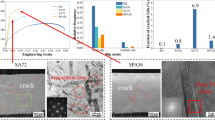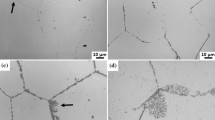Abstract
A solid-solution treated Al–Cu binary alloy ingot containing 2.42 wt% copper was subjected to a multi-directional forging at ambient temperature followed by a recrystallization annealing at 400 °C and aging at 175 °C. Then, the dependence of precipitate morphology on grain boundary types was studied by field emission scanning electron microscopy, electron backscatter diffraction and grain boundary trace analysis. The results show that no precipitate is found at the coherent twin boundaries (singular boundaries). Discontinuous or necklace-like precipitates are observed at the near singular (vicinal) boundaries with grain boundary inter-connections of {1 1 1}/{1 1 1} (excluding coherent twin boundaries), but continuous precipitates are developed at the random boundaries. A surface etching result indicates that the coherent twin boundaries are immune to, while the near singular boundaries are more resistant to intergranular corrosion compared to random boundaries. O-lattice theory analysis indicates that the near singular boundaries usually have specific atomic structure of periodic good matching sites isolated by the periodic dislocations. This could be the origin of discontinuous precipitates and higher resistance to intergranular corrosion in comparison with random boundaries. Based on the fact that coherent twin boundaries are hard to be introduced due to the high stacking fault energy, it is suggested that to purse a grain boundary character distribution containing high frequency near singular boundaries would be a promised approach to higher the resistance to intergranular corrosion for aluminum and its alloys in view of grain boundary engineering.









Similar content being viewed by others
References
Nair BS, Phanikumar G, Rao PK, Sinha PP (2007) Improvement of mechanical properties of gas tungsten arc and electron beam welded AA2219 (Al–6 wt% Cu) alloy. Sci Technol Weld Join 12:579–585
Takeda M, Maeda Y, Yoshida A (1999) Discontinuity of G.P.(I) zone and θ′-phase in an Al–Cu alloy. Scripta Mater 41:643–649
Dorin T, Ramajayam M, Langan TJ (2019) Impact of Scandium and Zirconium on extrudability, microstructure and hardness of a binary Al–Cu alloy. Mater Today 10:242–247
Dorin T, Ramajayam M, Lamb J, Langan T (2017) Effect of Sc and Zr additions on the microstructure/strength of Al–Cu binary alloys. Mater Sci Eng, A 707:58–64
Mulier IL, Galvele JR (1977) Pitting potential of high purity binary aluminium alloys-I. Al–Cu alloys. Pitting and intergranular corrosion. Corros Sci 17:179–193
Chen BA, Pan L, Wang RH, Liu G, Cheng PM, Xiao L, Sun J (2011) Effect of solution treatment on precipitation behaviors and age hardening response of Al–Cu alloys with Sc addition. Mater Sci Eng, A 530:607–617
Kairy SK, Turk S, Birbilis N, Shekhter A (2018) The role of microstructure and microchemistry on intergranular corrosion of aluminium alloy AA7085-T7452. Corros Sci 143:414–427
Kairy SK, Rouxel B, Dumbre J, Lamb J, Langan TJ, Dorin T, Birbilis N (2019) Simultaneous improvement in corrosion resistance and hardness of a model 2xxx series Al–Cu alloy with the microstructural variation caused by Sc and Zr additions. Corros Sci 158:108095
Wang ZX, Chen P, Li H (2024) The intergranular corrosion susceptibility of 2024 Al alloy during re-ageing after solution treating and cold-rolling. Corros Sci 114(2017):156–168
Watanabe T (1984) An approach to grain boundary design for strong and ductile polycrystal. Res Mech 11:47–52
Palumbo G, Erb U (1999) Enhancing the operating life and performance of lead-acid batteries via grain-boundary engineering. MRS Bull 11:27–32
Wang WG, Yin FX, Guo H, Li H, Zhou BX (2008) Effects of recovery treatment after large strain on the grain boundary character distributions of subsequently cold rolled and annealed Pb–Ca–Sn–Al alloy. Mater Sci Eng, A 491:199–206
Wang WG, Zhou BX, Rohrer GS, Guo H, Cai ZX (2010) Textres and grain boundary character distributions in a cold rolled and annealed Pb–Ca based alloy. Mater Sci Eng, A 527:3695–3706
Wang WG, Lin C, Li GH, Hua NB, Zhou BX, Fang XY, Dai PQ, Chen WZ (2014) Preferred orientation of grain boundary plane in recrystallized high purity aluminum. Sci Sin Technol 44:1295–1308
Bounchet D, Priester L (1986) Intergranular segregation and crystallographic parameters of grain boundaries in Nickel–Sulfur system. Scr Metall 20:961–966
Bounchet D, Priester L (1987) Grain boundary plane and intergranular segregation in Nickel–Sulfur system. Scr Metall 21:475–478
Janssens KGF, Olmsted D, Holm EA, Foiles SM, Plimpton SJ, Derlet PM (2006) Computing the mobility of grain boundaries. Nat Mater 5:124–127
Wang WG, Cai CH, Rohrer GS, Gu XF, Lin Y, Chen S, Dai PQ (2018) Grain boundary inter-connections in polycrystalline aluminum with random orientation. Mater Charact 144:411–423
Sutton AP, Balluffi RW (1995) Interfaces in crystalline materials. Clarendon Press, Oxford
Wright SI, Larsen RJ (2002) Extracting twins from orientation imaging microscopy scan data. Microcopy 205:245–252
Fang XY, Wang WG, Guo H, Zhang X, Zhou BX (2007) Corrosion behaviors of random and special grain boundaries in a sensitized 304 stainless steel. J Iron Steel Res Int 14:339–343
Li H, Maex K, Brijs B (1998) Segregation of Cu on etched and non-etched Al(Cu) surface. MRS Proc 516:77–82
Wang WG, Chen S, Rohrer GS (2017) The inter-connections of ∑3 boundaries in pure iron. Scripta Mater 128:18–22
Zhang WZ (2002) Application of the O-lattice model to the calculation of the interfacial dislocations. Acta Metall Sin 38:785–794
Kronber ML, Wilson FH (1949) Secondary recrystallization in copper. Trans AIME 185:501–514
Mackenzie JK (1958) Second paper on statistics associated with the random disorientation of cubes. Biometrika 45:229–240
Wang S, Fan CZ (2019) Crystal structures Of Al2Cu revisited: understanding existing phases and exploring other potential phases. Metals 9:1037
Sauvage X, Enikeev N, Valiev R (2014) Atomic-scale analysis of the segregation and precipitation mechanisms in a severely deformed Al–Mg alloy. Acta Mater 72:125–136
Bollmann W (1974) O-lattice calculation of an F.C.C.–B.C.C. interface. Phys Status Solidi A 21:543–550
Grimmer H, Bollmann W, Warrington DH (1974) Coincidence-site lattices and complete pattern-shift lattices in cubic crystals. Acta Cryst Sect A 30:197–207
Acknowledgements
This work was supported by the Natural Science Foundation of China (NSFC) under the Contract No. 51971063 and the special program for guiding local science and technology development by the central government under the Contract No. 2019L3010. The authors have many thanks to professor Wenzheng Zhang from Tsinghua University for her helpful suggestions and discussions concerning the O-lattice application in the present work.
Author information
Authors and Affiliations
Corresponding author
Additional information
Handling Editor: N. Ravishankar.
Publisher's Note
Springer Nature remains neutral with regard to jurisdictional claims in published maps and institutional affiliations.
Rights and permissions
About this article
Cite this article
Du, A., Wang, W., Gu, X. et al. The dependence of precipitate morphology on the grain boundary types in an aged Al–Cu binary alloy. J Mater Sci 56, 781–791 (2021). https://doi.org/10.1007/s10853-020-05239-5
Received:
Accepted:
Published:
Issue Date:
DOI: https://doi.org/10.1007/s10853-020-05239-5




